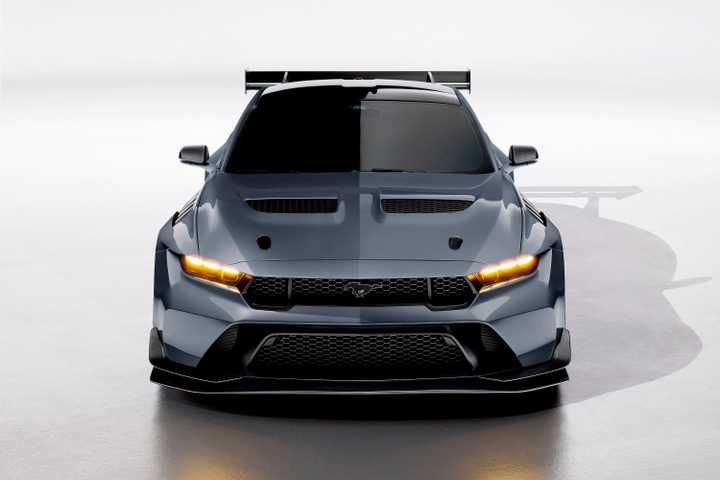I’m a journalist, not a racing driver, and typically when looking at a speedometer on a track, I’m either 1) driving pretty slowly because the pit lane is coming up or 2) about to get into a little bit of trouble. Unlike pro drivers, who seem to be able to multitask while setting world records, car bloggers should really keep both hands on the wheel and both eyes scanning for the next apex cone.
But in the 2025 Ford Mustang GTD – a race car for the road that happens to blend uncanny speed with unbelievable drivability – the level of comfort at track pace stood out. Testing the new car at the Thermal Club track, west of Palm Springs in southern California, I found myself comfortable checking my speedo as I rushed up to the righthander that followed the back straight.
Confidence generated by the grip level, braking, and steering response didn’t exactly turn me into an IMSA driver, but it sure did give me an ego boost.


- Base Trim Engine
-
5.2L Supercharged V8 Gas
- Base Trim Transmission
-
8-speed Dual-clutch transaxle Automatic
- Base Trim Drivetrain
-
Rear-Wheel Drive
- Base Trim Horsepower
-
800 hp
- Fuel Economy
-
TBC
- Make
-
Ford
- Model
-
Mustang GTD
- Segment
-
Sports Car
Pros
- The engine is an absolute monster, with great top-end power and enough torque to cover some missed shifts
- Grip, thanks to perfect tires and great aero, is really impressive at high speeds
- Somehow, the car rewards drivers of all skill levels
Cons
- Take out a second mortgage if Ford allows you to buy one
- As a road car, GTD is a ton of fun but very intense
- Subtlety isn’t a strong suit of this bonkers design
Power, Balance, And Perfect Gear Shifts
From behind the steering wheel or from a few blocks away, the supercharged, 5.2-liter “Predator” V8 sounds like an absolute menace. The engine note from the free-breathing exhaust is flat, hard, and resonant, rising in pitch paced to match the super-fast spin up to the 7,400 RPM redline. This powertrain produces 815 horsepower and 664 pound-feet of torque, and pulls like hell out of a corner on the racetrack, even if I’ve gone in a gear too high.
There’s a rear-mounted, eight-speed dual-clutch transaxle managing power to the rear tires (and helping to give the GTD a nearly 50/50 front/rear weight distribution). In full manual mode, the Tremec-built transmission let me snap off shifts in an eye blink.
The steering-wheel-mounted paddle shifters are just perfect in track use, cracking off up-shifts in time with the free-revving engine, and causing a massive rip of exhaust with every aggressive gear down to enter a corner.
In fact, I liked the DCT so much that I can even forgive the fiddly rotary gear selector on the tunnel.
Exterior Dimensions
|
Length |
193.6 Inches |
|
Width |
81.9 Inches |
|
Height |
55.5 Inches |
|
Wheelbase |
107.1 Inches |
|
Front Track |
67.9 Inches |
|
Rear Track |
68.3 Inches |
|
Curb Weight |
4,386 Pounds |
Grip It To Rip It
With all of that power and rear-wheel drive, you might expect the GTD to be a handful at track speeds, but the reality is a high level of user-friendliness from the very start. Part of that is down to the fat tires – 20-inch wheels all the way around are wrapped in 345-section Michelin Pilot Sport Cup 2R tires in the back, and 325 sections in the front.
Truly world-class rubber, the Cup 2Rs were almost impossible to get unstuck, even during aggressive transitions on track. I was able to make the back end of the GTD come around more than expected exactly once in a day of lapping, and then only after I’d switched traction control completely off and gotten comfortable enough with the circuit layout to get a little too brave.
In really high-speed sweeping turns and quick-change chicanes, this Mustang feels completely stuck to the tarmac. Lest I forget – and how could I with the giant front splitter and rear wing – engineers have optimized the GTD for some incredible aero performance, too. With the optional performance pack added and the drag reduction system off, the car generates a staggering 1951 pounds of downforce at 180 miles per hour (or a still-impressive 941 pounds at 125 mph). There’s nothing like adding two tons of encouragement to very sticky tires.
Performance Specifications
|
Engine |
Supercharged 5.2-Liter V8 |
|
Transmission |
Eight-Speed Dual-Clutch Automatic |
|
Drivetrain |
Rear-Wheel Drive |
|
Power |
815 Horsepower |
|
Torque |
664 Pound-Feet |
|
0-60 |
3.0 Seconds (est.) |
|
Top Speed |
202 MPH |
Better Handling Through Science
With all of that mechanical grip on tap, Ford’s approach to its variable traction control system makes a lot of sense. In GTD, the VTC system comes with selectable levels of intervention (including full off) available while the car is set to Track mode.
In the Track setting, the Mustang’s race-derived in-board rear suspension setup comes into crisp focus. The foundation of this state-of-the-art system is the Multimatic Adaptive Spool Valve (ASV) damper on each of the rear shocks. Inspired by racing, ASV technology allows for precise control and real-time adjustments, ensuring optimal contact with the road surface.
Track mode also compresses one of the two springs in each damper, dropping the GTD height some 1.6 inches (40 millimeters), and effectively doubling the spring rates.
The net effect here is impressive. A car that is already quite willing to rotate and stick in a corner becomes, quite literally, one of the best handling cars I’ve ever tested. GTD changes direction on a dime, but feels utterly stable powering out of a corner at full throttle.
The winged Mustang also has some of the most responsive steering I’ve sampled this side of a McLaren; quick to turn in and bite, and easy to modulate through challenging S-bends or near-hairpin left-handers. While the levels of feedback could be higher (something I miss more on the road than on the track), the steering experience is marvelously well-judged overall.
Interior Specifications
|
Headroom |
37.6 Inches |
|
Shoulder room |
56.3 Inches |
|
Hip room |
54.9 Inches |
|
Legroom |
42.7 Inches |
If We’re Forced To Pick A Few Nits…
If you made it this far, you might be convinced that the Mustang GTD is a perfect performance car and an out-of-the-park home run for Ford. Time will tell if the former is true (though production of the car in the first year does appear to be sold out), but the latter is demonstrably false. For all of its capability and soul, the GTD isn’t without some flaws.
There’s the price: $325,000 for the base car and more still to add the exceptional performance pack that makes the car lighter and offers the best aero package. (To be clear, Ford hasn’t finalized pricing as of this writing, but we expect the MSRP to be in that ballpark, and the performance package to hit around $10,000.)
Those are acceptable figures considering they buy you a true racecar for the road, but it takes the Mustang into a price point that the marque hasn’t ever sniffed on a production car. Moreover, it eclipses the roughly $250k base price for the Porsche 911 GT3 RS.
Overall, I think GTD is great for the Mustang brand, but the sticker price could be a stretch for ultra-luxury and exotic car buyers who are used to more in the way of creature comforts.
Don’t get me wrong, the GTD interior is a perfectly suitable place to go to work on a racetrack or your favorite canyon road. But fit, finish, and material quality are a grade below the Porsche, to be sure.
Finally, while using the Mustang GTD as a road car will likely be limited to the occasional Sunday drive, it isn’t exactly a paragon of NVH tuning. The car is loud, from just about every corner. It’s also thirsty, and doesn’t have a trunk – that high-speed IKEA run is right out.
Last Lap
I’ve been doing this for 20 years, and I can honestly say that I’ve only driven a handful of cars as compelling on a track as the Mustang GTD. And among that small group, the Ford may be tops in terms of complementing the driver as confidence and speed build.
The GTD is special. It’s the paragon of one of the most important sports cars in the world, for one of our longest-lasting brands. The price and availability will be too high a hurdle for most, but anyone lucky enough to turn a lap in this ultra pony car isn’t likely to forget it.

















